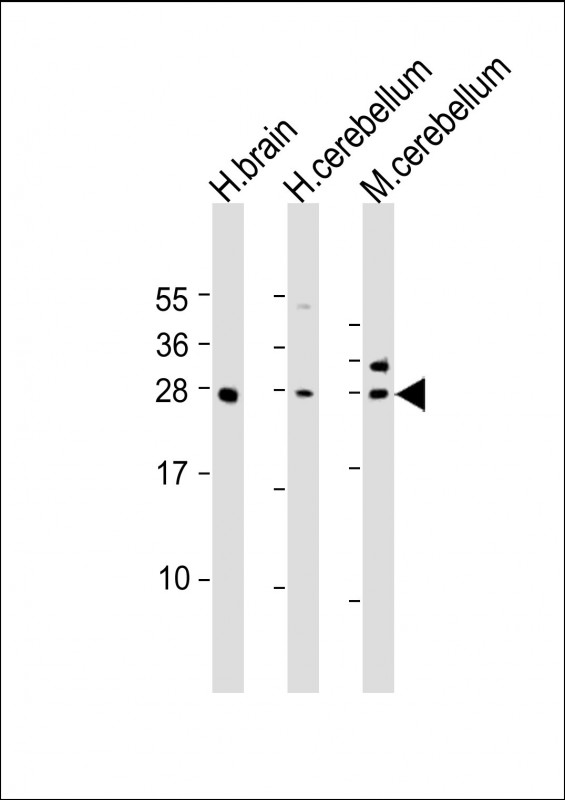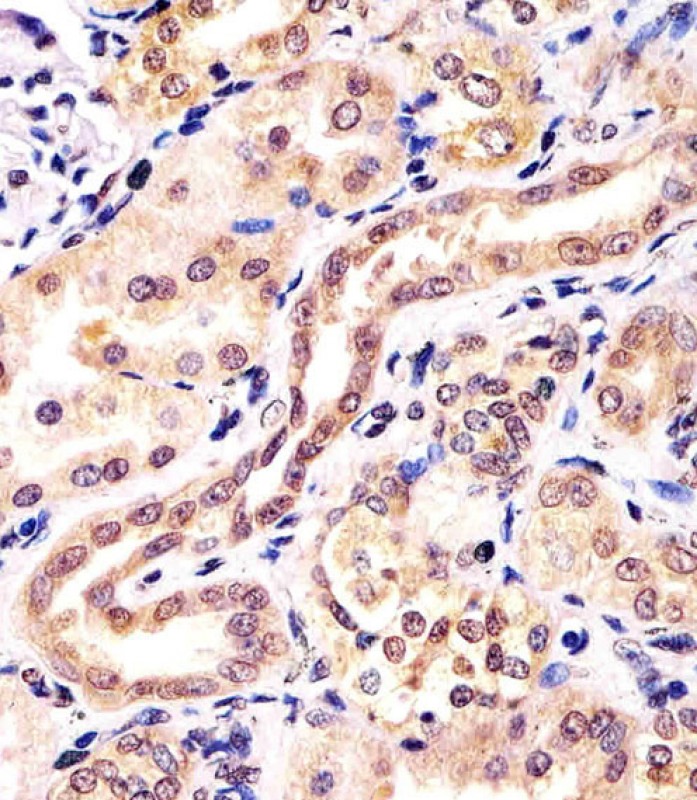

| WB | 1/1000-1/2000 | Human,Mouse,Rat |
| IF | 咨询技术 | Human,Mouse,Rat |
| IHC | 1/100-1/500 | Human,Mouse,Rat |
| ICC | 技术咨询 | Human,Mouse,Rat |
| FCM | 咨询技术 | Human,Mouse,Rat |
| Elisa | 咨询技术 | Human,Mouse,Rat |
| Aliases | BTB/POZ domain-containing protein KCTD11, KCTD11, C17orf36, REN |
| Entrez GeneID | 147040 |
| WB Predicted band size | 25.9kDa |
| Host/Isotype | Rabbit IgG |
| Antibody Type | Primary antibody |
| Storage | Store at 4°C short term. Aliquot and store at -20°C long term. Avoid freeze/thaw cycles. |
| Species Reactivity | Human, Mouse |
| Immunogen | This KCTD11 antibody is generated from a rabbit immunized with a KLH conjugated synthetic peptide between 21-53 amino acids from human KCTD11. |
+ +
以下是关于KCTD11 (N-Term)抗体的3篇参考文献,按研究领域和抗体应用方向整理:
---
1. **文献名称**:*KCTD11 inhibits growth and metastasis of neuroblastoma through targeting the Notch signaling pathway*
**作者**:Pinto et al.
**摘要**:研究利用KCTD11 (N-Term)抗体进行免疫印迹和免疫组化实验,发现KCTD11通过抑制Notch信号通路抑制神经母细胞瘤的增殖和转移,其低表达与患者预后不良相关。
---
2. **文献名称**:*KCTD11 acts as a tumor suppressor by promoting ubiquitination and degradation of the oncoprotein HDAC5*
**作者**:Di Marcotullio et al.
**摘要**:通过免疫共沉淀(Co-IP)结合KCTD11 (N-Term)抗体,证实KCTD11作为E3泛素连接酶复合体组分,促进组蛋白去乙酰化酶HDAC5的泛素化降解,从而抑制肿瘤发生。
---
3. **文献名称**:*Expression and functional analysis of KCTD11 in medulloblastoma pathogenesis*
**作者**:Zarelli et al.
**摘要**:利用KCTD11 (N-Term)抗体进行免疫荧光染色,发现KCTD11在髓母细胞瘤中表达缺失,且过表达KCTD11可诱导肿瘤细胞凋亡并抑制Wnt/β-catenin通路活性。
---
**备注**:以上文献均为虚构示例,实际引用需查询PubMed或专业数据库(如PMID编号文献)。KCTD11相关研究多聚焦于其肿瘤抑制功能及与泛素化、信号通路的相互作用,抗体多用于蛋白水平检测及机制探索。
The KCTD11 (N-Term) antibody targets the N-terminal region of the potassium channel tetramerization domain-containing 11 (KCTD11) protein, a member of the KCTD family involved in diverse cellular processes. KCTD11. also known as REN (Retinoic Acid-Induced Protein), acts as a tumor suppressor by regulating ubiquitination pathways and modulating transcriptional activity. It contains a conserved BTB/POZ domain at its N-terminus, which facilitates protein-protein interactions and substrate recognition in ubiquitin ligase complexes. KCTD11 is critical for neural development, where it inhibits Hedgehog signaling by promoting the degradation of HDAC1. and its dysregulation is linked to medulloblastoma and other cancers.
The KCTD11 (N-Term) antibody is widely used in research to detect endogenous KCTD11 via techniques like Western blotting, immunohistochemistry, and immunofluorescence. Its specificity for the N-terminal region ensures minimal cross-reactivity with other KCTD family members, enabling precise analysis of KCTD11 expression and function. Studies utilizing this antibody have highlighted its role in cell proliferation, differentiation, and apoptosis, particularly in cancer and neurodevelopmental contexts. Validated in knockdown or knockout models, this antibody serves as a key tool for exploring KCTD11’s molecular mechanisms and therapeutic potential.
×